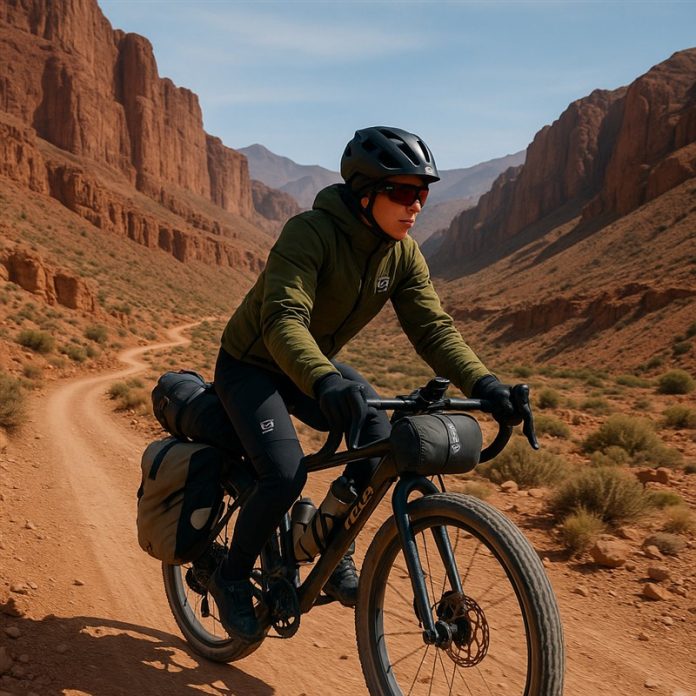Introduction
The Atlas Mountain Race is one of the most demanding and visually captivating ultra-endurance bikepacking events in the world. Held annually in Morocco, this self-supported race draws adventure cyclists and ultra-distance riders from around the globe to tackle rough terrain, remote landscapes, and significant elevation gain. With its mix of traditional Berber villages, ancient mountain passes, and desert crossings, the race challenges riders not only physically but mentally, requiring strategic thinking, meticulous preparation, and unwavering determination.
The Atlas Mountain Race offers no prize money, no podium, and no frills—just a test of pure endurance and self-sufficiency against some of the most unforgiving landscapes in North Africa.
History of The Atlas Mountain Race
The race was founded by Nelson Trees, also known for his role in creating the Transcontinental Race. Inspired by the desire to offer an ultra-distance bikepacking experience outside Europe, he scouted Morocco for its vast, untapped terrain and culturally rich environment. The inaugural Atlas Mountain Race took place in February 2020, quickly gaining international acclaim for its blend of harsh yet beautiful conditions and its dedication to the spirit of unsupported endurance cycling.
Despite the logistical complexities of holding such an event in a remote region, the race has grown rapidly in popularity. Its appeal lies in the wildness of the route, the necessity for complete self-reliance, and the incredible sense of adventure that defines every pedal stroke.
Location of the Event
The race is set in the Atlas Mountains of Morocco, primarily weaving through the High Atlas and Anti-Atlas ranges. Riders begin their journey in Marrakech, a bustling city known for its colourful souks and historic medinas, and traverse vast, arid landscapes all the way to the Atlantic coastal town of Agadir.
This unique setting provides a dynamic backdrop for the race: dramatic mountain peaks, rocky passes, dry riverbeds (wadis), remote villages, and open desert tracks. Elevation, temperature extremes, and isolation are constant companions throughout the route.
Riders encounter every kind of terrain—technical singletrack, dirt roads, river crossings, and rough gravel—all framed by the stunning Moroccan scenery and shaped by centuries of local history.
About the Event
When It Happens
The Atlas Mountain Race usually takes place in February, a time when the weather is cooler and more manageable for long-distance cycling across the desert and mountainous areas. This timing helps riders avoid the oppressive summer heat of Morocco, but still presents challenges in the form of cold nights and unpredictable conditions in the higher altitudes.
The Route
The route changes slightly each year but remains a fixed point-to-point format. In 2024, the distance was approximately 1,300 kilometres (around 800 miles) with an elevation gain of more than 25,000 meters (82,000 feet). The course is unmarked and participants are provided with a GPS route they must follow precisely, with only a few mandatory checkpoints.
The race is unsupported, meaning riders must carry their own food, water, repair kits, and sleeping equipment. They cannot accept outside assistance except from commercial establishments like shops or hotels.
Notable Route Features
- Tizi n’Test Pass – One of Morocco’s most famous climbs, with steep gradients and incredible views.
- Jbel Sirwa – A rugged volcanic mountain range that tests both navigation and climbing legs.
- Anti-Atlas – An unforgiving range with remote, rocky terrain and very little infrastructure.
Timing and Expectations
There is no official time cut-off, but most riders aim to finish in 7 to 10 days, with the front-runners completing the race in 3 to 5 days. Sleeping outdoors, navigating under the stars, and rationing supplies are all part of the experience. GPS trackers are used for safety and tracking, and all participants must follow a strict code of self-support and fair play.
Riders face extreme fatigue, physical pain, sleep deprivation, and mental isolation. Yet, those who finish often describe it as one of the most rewarding achievements of their cycling careers.
Key Details to Know
| Feature | Details |
|---|---|
| Start Location | Marrakech, Morocco |
| Finish Location | Agadir, Morocco |
| Distance | ~1,300 km |
| Elevation Gain | 25,000m+ |
| Duration | 3–10 days (depending on rider) |
| Support Level | Fully unsupported |
| Entry Type | Application-based |
| Ideal Bike | Gravel or rigid mountain bike with bikepacking setup |
| Best Preparation | Long-distance gravel riding, GPS navigation, endurance training, desert and mountain conditioning |
Atlas Mountain Race Winners 2020 to 2024
Includes both male and female categories along with their respective finish times:
| Year | Male Winner | Time | Female Winner | Time |
|---|---|---|---|---|
| 2024 | Justinas Leveika | 3d 19h 16m | Cynthia Carson | 5d 17h 58m |
| 2023 | Robin Gemperle | 3d 20h 15m | Luisa Werner | 5d 17h 58m |
| 2022 | Marin de Saint-Exupéry | 3d 18h 14m | Ashley Carelock | 6d 10h 0m |
| 2021 | Event Cancelled | – | Event Cancelled | – |
| 2020 | Sofiane Sehili | 3d 21h 50m | Lael Wilcox | 6d 0h 0m |
Note: The 2021 event was cancelled due to the COVID-19 pandemic.
Summary
The Atlas Mountain Race is not just another cycling event—it’s a journey into the heart of adventure bikepacking. From the majestic peaks of the Atlas Mountains to the silence of the Moroccan desert, this race offers more than physical challenge; it’s a test of mental strength, resilience, and self-reliance.
For anyone looking to push the boundaries of long distance cycling in one of the world’s most visually stunning and remote regions, the Atlas Mountain Race stands out as a must-experience challenge. Whether you’re a seasoned ultra-racer or a bikepacker seeking the ultimate ride, this event offers an unforgettable test of endurance and exploration.
If you’re planning to attempt the race, preparation is key. Invest in gear that can handle rough terrain, train for both elevation and distance, and most importantly, adopt a mindset ready for the unexpected. Because in the Atlas Mountains, the route will test your limits—and that’s exactly why riders come back year after year.












